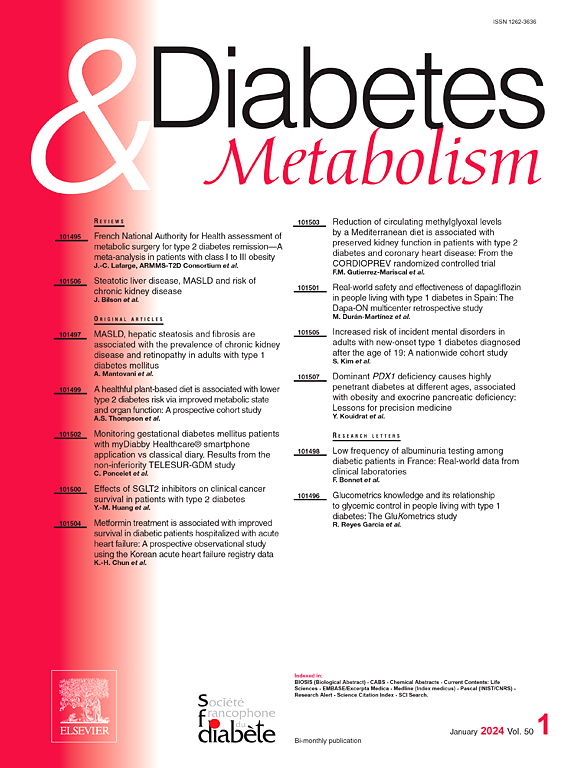脂肪酸结合蛋白4水平升高与2型糖尿病患者发生视网膜病变的风险相关
IF 4.7
2区 医学
Q1 ENDOCRINOLOGY & METABOLISM
引用次数: 0
摘要
脂肪酸结合蛋白4 (FABP4)与糖尿病及其微血管并发症的发生风险相关。我们旨在探讨血清FABP4水平与2型糖尿病(T2DM)患者糖尿病视网膜病变(DR)风险之间的关系。方法采用酶联免疫吸附法测定275例(健康对照78例,T2DM患者197例)血清FABP4水平。通过眼底荧光血管造影确定DR严重程度。通过logistic回归模型进行多变量分析。通过受试者工作特征曲线分析评估这些指标的诊断价值。结果增殖性DR (PDR)组血清FABP4水平显著高于无增殖性DR (ZDR)和非增殖性DR (NPDR)组,且与DR严重程度呈正相关(r = 0.328, P <;0.001)。Logistic回归分析显示,在调整潜在混杂因素后,FABP4、空腹血糖(FPG)和血红蛋白A1c (HbA1c)水平升高是DR发生的危险因素,FABP4是PDR发生的独立危险因素。将FABP4作为分类二元变量(截断值为20.57 ng/ml)的多因素logistic回归模型显示,高于截断值的FABP4水平增加了DR风险(OR=6.394;95% ci =3.18;13.58;P & lt;0.001)。同样,高于临界值24.40 ng/ml的FABP4浓度会增加PDR风险(OR=4.686;95% ci =1.907;12.34;P = 0.001)。结论FABP4水平与DR严重程度相关,可作为预测DR的血清生物标志物。本文章由计算机程序翻译,如有差异,请以英文原文为准。
Increased fatty acid-binding protein 4 levels are associated with the risk of developing retinopathy in type 2 diabetes mellitus patients
Aim
Fatty acid-binding protein 4 (FABP4) is associated with the risk of developing diabetes and its microvascular complications. We aimed to explore the association between serum FABP4 levels and the risk of diabetic retinopathy (DR) in patients with type 2 diabetes mellitus (T2DM).
Methods
Serum FABP4 levels were measured via enzyme-linked immunosorbent assay in 275 individuals (78 healthy controls, 197 T2DM patients). DR severity was determined via fundus fluorescence angiography. Multivariate analyses were performed via logistic regression models. The diagnostic value of these measures was assessed via receiver operating characteristic curve analysis.
Results
Serum FABP4 levels were significantly greater in the proliferative DR (PDR) group than in the ZeroDR (ZDR) and non-proliferative DR (NPDR) groups, and the FABP4 levels positively with DR severity (r = 0.328, P < 0.001). Logistic regression analysis revealed that after adjusting for potential confounders, increased FABP4, fasting plasma glucose (FPG) and hemoglobin A1c (HbA1c) levels were risk factors for DR development, and FABP4 was an independent risk factor for PDR development. A multivariate logistic regression model that included FABP4 as a categorical binary variable with a cutoff value of 20.57 ng/ml revealed that a level of FABP4 above the cutoff value increased the DR risk (OR=6.394; 95 % CI=3.18;13.58; P < 0.001). Similarly, a FABP4 concentration above the cutoff value of 24.40 ng/ml increased the PDR risk (OR=4.686; 95 % CI=1.907;12.34; P = 0.001).
Conclusion
The FABP4 level is associated with DR severity and has the potential as a serum biomarker for DR prediction.
求助全文
通过发布文献求助,成功后即可免费获取论文全文。
去求助
来源期刊

Diabetes & metabolism
医学-内分泌学与代谢
CiteScore
12.00
自引率
4.20%
发文量
86
审稿时长
13 days
期刊介绍:
A high quality scientific journal with an international readership
Official publication of the SFD, Diabetes & Metabolism, publishes high-quality papers by leading teams, forming a close link between hospital and research units. Diabetes & Metabolism is published in English language and is indexed in all major databases with its impact factor constantly progressing.
Diabetes & Metabolism contains original articles, short reports and comprehensive reviews.
 求助内容:
求助内容: 应助结果提醒方式:
应助结果提醒方式:


